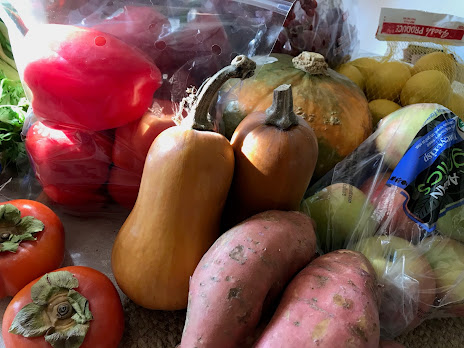What Is Chinese Five Elements Theory?
Chinese Five Elements Theory elegantly expresses the processes of change continually occurring in the natural world ~ and the interconnectedness of all life. Humans are part of the natural world, and subject to these unavoidable natural cycles of creation, maturation, and death. They occur within us, not just around us.
Each of our trillions of cells are continuously changing. As they age and get damaged, they replicate themselves before they die off. The cellular turnover rate varies, depending upon the organ or area of the body. For example, the cellular turnover of our skin and gut is much quicker than that of our liver or heart.
When we eat and live in harmony with these natural daily, monthly, and seasonal fluctuations ~ we enjoy greater balance, harmony and health. Eating a healthy diet rich in antioxidants, and phytonutrients found only in plants provides the appropriate nourishment to aid with healthy cellular turnover.
You could definitely say, that over time, we are what we eat, yet, we are also what we don't eat. And, perhaps even more true, we become what we think. Therefore, it is essential to take in the best quality food for our body, mind and spirit in order to really thrive and flourish.
The Chinese Medicine Tool Bag
Chinese Five Elements Theory is used in Chinese medicine as a system for observing patterns of disharmony, and for crafting an appropriate treatment plan.
Taoist practices, including Five Elements Theory ~ also referred to as the Five Phases, or Five Energy Transformations ~ date back at least three thousand years, and is considered to be the root of Chinese medicine.
In the West, most people think Chinese medicine = acupuncture, but this is far from true. Chinese medicine utilizes a variety of holistic therapies, including Chinese nutrition or food therapy, herbal medicine, Qi Gong as a healing therapy, and personal practice, Tai Chi practice, cupping, gua sha (a scraping technique), tui na (a form of physical therapy and structural or physical manipulation), and finally, acupuncture.
 |
| (Royalty-free image) |
Chinese Five Elements Theory can be utilized to help determine the best dietary choices for individual needs, which will vary depending upon one's constitution, current condition, and the season. This is also a precept used in macrobiotics, along with the universal principle of balance, or Yin / Yang Theory, which, unfortunately, the early Japanese teachers of macrobiotics inverted. More on that in a future post.
Five Elements Creation or Controlling Cycles
When viewed written on a circle, the order of the five elements is as follows: Wood, Fire, Earth, Metal, Water, and back to Wood.
The five elements has a (natural) creative, or supportive / engendering relationship with the subsequent element. This is also referred to as a parent / child relationship. For example, Wood can create, and is burnt in a Fire, which turns to ash, and becomes part of the Earth. The Earth produces Metals (minerals) which can be melted into a liquid state, or evaporated into Water. For example, Wood is the 'Mother' or Parent of Fire, which is the Child of Wood, but the Parent of Earth, and so on.
Plants and trees grow and mature and eventually bear fruit. Seeds are released to create the next generation of plants, like producing like. Just like our cells replicating themselves in the ever changing cycles of life.
Aside from the unchanging principles and Creative Life Force Energy which formed the foundation of the natural world, the only true constant is that everything changes.
A Controlling or Contentious relationship is one that obstructs this natural generative cycle, or is used to control another element. For example, we can use earth elements ~ dirt or sand ~ to build a dam or barrier to control excess water or flooding. Water can in turn put out a fire. Roots of trees (Wood) can invade the Earth, obstructing growth of nearby plants. And an axe (Metal) can cut down trees in areas of over growth.
So how does Chinese Five Elements Theory apply to human health?
According to Chinese medicine, the organs have energies beyond just the biological functions identified in Western sciences. The liver, for example, is responsible for the smooth flow of energy (Qi or Chi) throughout the entire body ~ among other functions. Like newly sprouted seeds, which burst through the soil, we too like to reach up and out towards the sun after a long, cold, grey winter.
Each element is associated with a yin and yang paired organ system ~ with the exception of the Fire element having two extra channels that are not attributed to an organ, but rather a specific function within the body ~ along with a sense organ, climate, emotion, color, taste, sound, and more.
Having an understanding of the five elements, and their corresponding seasons, organs, tastes, and emotions can help us recognize when we are getting out of balance, and make appropriate corrections to regain a sense of ease and flow.
From a broader perspective, Chinese five elements can be used like an operating system, and tool for self-healing. When we pay attention to our body, and the symptoms we are experiencing, we can correct minor imbalances before they become more complicated, chronic ~ and debilitating!
Chinese Five Elements Theory is used in Chinese medicine practice for helping discern pattern disharmonies, and for recommending an appropriate course of treatment, which typically would include food therapy and herbal medicine.
The main categories of each of the five elements are as follows, listed in order of Element, Climate, Yin Organ, Yang Organ, Sense Organ, Emotions, Color & Taste:
- Wood - Spring; Wind; Liver & Gallbladder; Eyes; Frustration and its offshoots of Anger, Bitterness, Resentment &/or Rage; Green; Sour
- Fire - Summer; Heat; Heart & Small Intestine (+) Triple Energizer (Sanjiao) & Heart Protector (Pericardium); Tongue; Joy / Over Joy, Shock or Mania; Red; Bitter
- Earth - Late Summer / Transitional Season; Damp; Spleen & Stomach (& by default, Pancreas); Mouth; Worry/ Over Thinking & Anxiety; Yellow; Sweet / Bland
- Metal - Fall; Dry; Lungs & Large Intestine; Nose; Grief / Sadness; White; Pungent
- Water - Winter; Cold; Kidneys & Urinary Bladder; Ears; Fear; Navy or Black; Salt
Chinese Medicine & Five Elements In Practice ~ Wind-Cold Versus Wind-Heat
Since it is spring as I write this post, I'll briefly look at the Wood element as an example for how we apply Chinese Five Elements Theory as part of our determining the pattern of disharmony, and determining the appropriate treatment.
During the spring, winds can stir up the pollens, challenging our immune system as allergies flare up. Wind can harken change, and be exhilarating at first. However, ongoing strong winds can disturb our psyche, or spirit (referred to as shen in Chinese medicine) causing us to feel a bit disoriented.
In Chinese medicine, the wind is considered the driver of external pathogens, which enters the 'wind gate' area at the base of the skull on the back of the neck, driving in the cold. (Wearing a scarf on cool, windy days, or even in air conditioned buildings protects this vulnerable area on the back of the neck.)
In Chinese medicine, a Wind-Cold is the early stages of a cold or flu bug, when we feel tired and run dow, with tension all through our body, but especially around our shoulders and neck area. We may have the chills, prefer hot soups and beverages, and have an aversion to being out in the cold and wind. Our tongue will have a more pale, or pale purplish color, with a white tongue coat.
A Wind-Heat indicates the pathogen has deepened, with more hot related symptoms, such as a sore throat and/or a fever. Our tongue may have a thin yellow tongue coat, or appear more red.
A patient presenting with a Wind-Cold would take foods and herbs which warm the body, and drive out the pathogen. A patient presenting with a Wind-Heat would need to modify the herbs to cool off the excess heat. If that person were to take the same herb and food combination as used to treat a Wind-Cold, it would be too warming, further driving in the pathogenic heat.
In Chinese Five Elements, Wind is also associated with symptoms that move about, such as dizziness, or pain and itchiness that is not fixed in one place. Each of these conditions reflect disharmonies involving the Wood element, and the Liver and/or Gallbladder. (Read more about the Liver and Wood element in the next article.)
Alternatively, if a client were to present with symptoms of pain or stiffness in the shoulders or neck area, possible changes to elimination, and is dealing with frustrations and stress at work or at home, we would direct the treatment and diet or herbal recommendations to treat the Liver, along with the areas of pain. If left untreated, symptoms such as premenstrual syndrome, hypertension, high blood pressure, headaches, and others could manifest.
Stress & The Five Elements Adaptive Types
There are other applications for Chinese Five Elements Theory, including as a means for restoring balance to the predominant emotional states, and ways of coping with life circumstances.
In Power of the Five Elements, The Chinese Medicine Path to Healthy Aging and Stress Resistance, Charles A. Moss, MD discusses the adaptive styles associated with each of the five elements. As an example, with respect to the Wood element, he states, "The adaptive abilities of a Wood Type person are represented by the archetypes of the Visionary and the Warrior. When adapted, Wood Types derive tremendous vitality through maintaining a vision where they want to go in the future and how they can make it happen."
If you would like to learn more, here, be sure to subscribe to the blog, as I will be writing more posts about Chinese Five-Elements Theory, and how to apply this to self-healing. My next post will look more in detail at the Wood element, and the best foods to eat during the spring season to nourish your liver.
Below are my top recommended books for further reading.
Any purchases made from the links provides a small commission to me, helps support my work on the blog, and is greatly appreciated!
You may also enjoy reading about the I Ching in my post,
Lake Over Lake, Reflection & Joy ~ another very insightful way of understanding the Chinese five elements, and the enduring cycles of change ~ and how it applies to your life.
Up next,
Liver & Gallbladder disharmonies, and the best
foods and herbs to enjoy in the spring to keep your liver happy! Let me know if you enjoy these types of informative posts about Chinese medicine and Chinese Five Elements Theory!










Comments
Post a Comment
Let me know what you think! I'd love to hear from you!